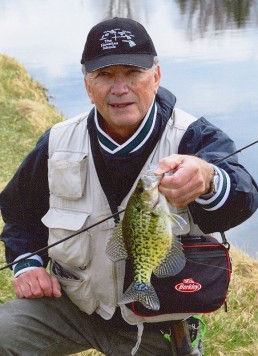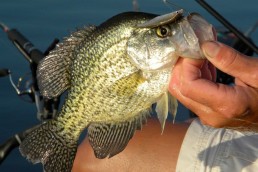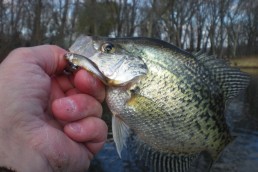On a Quest for Crappies
SHARE THIS POST
With a hard cast, the jig and bobber landed about 20 yards out from the shore of the 4-acre farm pond. And after retrieving the lure no more than 30 feet, the bobber suddenly slipped below the surface as hefty crappies latched onto the jig and 2-inch Berkley Power Minnow. After a brief, but spirited struggle, I gently slid a 12-inch black crappie onto the shore. After another hour later, I ended up with a total of 14 crappies, with the largest in the 12-inch class and the rest around 10 inches.
This was in early March, and with the weather being milder than normal, there was some really good early-season angling. As I mentioned earlier, the lure of choice on this trip was one of my favorite crappie lures—a Berkley Power Minnow in Emerald Shiner Pattern teamed with a 1/16- ounce jig head. The bobber that day, and on most, was the Betts Mr. Crappie Rattlin Pear 1-inch bobber. Over the past three seasons I have used this type of bobber with success, mainly because it contains several tiny BBs that not only add a little more weight for casting distance, but also emit a subtle rattling sound that attracts crappies as well as bluegills and bass.
The rod and the reel and line combo on this outing was a 7 1/2-foot B‘n’M Super Sensitive medium-light spinning rod teamed with a Mitchell 308 reel spooled with 8-pound-test Berkley NanoFil line. Whenever more casting distance is needed, I’ll switch to an 8-foot, light-action rod with either the same reel or a wider-spool reel wit either NanoFil or a premium monofilament line at 4- or 6-pound-test.
If I need a little more for casting distance for the small plastic lures, I’ll go with a 1/32 ounce. This size is rather unusual, but fills the gap between a 1/16- and 1/8-ounce jig.
The jig and bobber method is especially effective when fishing shallow bays or along riprap. Most of my crappie fishing is done from shore, so I’m always prepared to move when the action subsides in a particular area. And if I want to cover more water quickly I’ll go with lures that enable me to fish shallow or deeper and put out more flash or vibration. And “search bait” I use not only produces nice-sized crappies, but also big bluegills and bass. A good rod for casting big these lures would be a light- action model along with a light or ultra-light reel with 4-pound-test Gamma Polyflex line.
Are you enjoying this post?
You can be among the first to get the latest info on where to go, what to use and how to use it!
On ponds and lakes that have brush and downed trees along the shorelines, I like to fish either Cubby Mini Mites or Custom Jigs & Spins’ Flu Flu jigs tipped with a waxworm or maggot under a bobber. Another option is the 1-inch Gulp Alive Minnow also fished with a 1/32- or 1/16-ounce jig under a bobber.
Last year, from April through the second or third week of May, I had outstanding results using minnows fished about 20 inches under a bobber. I would gently pitch this bait in and around brush and riprap. If the crappies were around, it wouldn’t take long to find out, as after a couple of twitches the bobber would often be pulled quickly under. Many of these black crappies were 11 to 12 inches, and as always, I would often release more fish than I would keep, trying to practice “selective harvest.”
As spring turns to summer and the days become warmer, the crappies move to deeper water and the glory days of the easier springtime fishing are replaced with more challenging conditions that require changes in tactics. I’ll still use a jig and Power Minnow, but by casting without a bobber, and letting the jig and lure sink slowly until I determine what depths they are at under these conditions, a long, light, sensitive rod is beneficial. Another option for warm-weather, deep-water crappies would be a Mini Mite or Flu Flu jig tipped with waxworms or fished under a sliding slip bobber. Slip floats that are made to attach or remove from a line without having to cut the line are inventive. Many are available in three different sizes to cover a variety of fishing conditions.
I’m a multi-species angler with bass, bluegills, and even catfish, but crappies are at the top of my list for their ability to provide fun and a tasty meal.
MWO
SHARE THIS POST
Did you enjoy this post?
You can be among the first to get the latest info on where to go, what to use and how to use it!
Don Banning
Don Banning has been an outdoor writer since 1972, and with MidWest Outdoors and several other publications since 1974. He has been a fishing educator, seminar speaker and is also an award-winning conservationist and life member of the Izaak Walton League of America. He is on the pro staff of the Jiffy Ice Drill Co.



